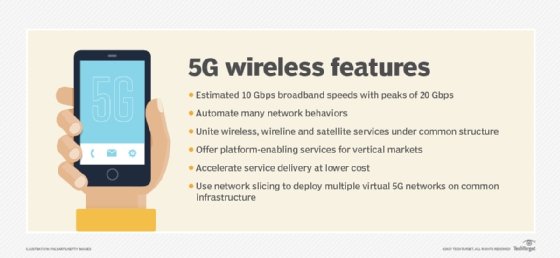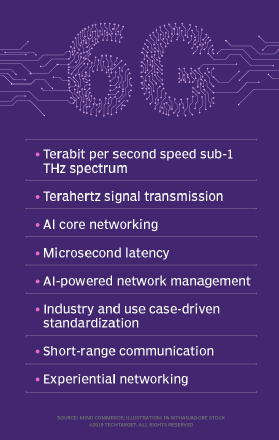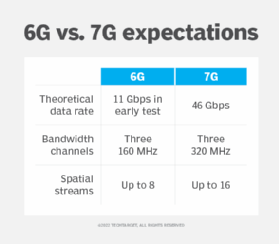What is 6G? Overview of 6G networks & technology
What is 6G?
6G (sixth-generation wireless) is the successor to 5G cellular technology. 6G networks will be able to use higher frequencies than 5G networks and provide substantially higher capacity and much lower latency. One of the goals of the 6G internet is to support one microsecond latency communications. This is 1,000 times faster -- or 1/1000th the latency -- than one millisecond throughput.
The 6G technology market is expected to facilitate large improvements in the areas of imaging, presence technology and location awareness. Working in conjunction with artificial intelligence (AI), the 6G computational infrastructure will be able to identify the best place for computing to occur; this includes decisions about data storage, processing and sharing.
It is important to note that 6G is not yet a functioning technology. While some vendors are investing in the next-generation wireless standard, industry specifications for 6G-enabled network products remain years away.
What are the advantages of 6G vs. 5G?
6G networks will operate by using signals at the higher end of the radio spectrum. It is too early to approximate 6G data rates, but Dr. Mahyar Shirvanimoghaddam, senior lecturer at the University of Sydney, suggested a theoretical peak data rate of 1 terabyte per second for wireless data may be possible. That estimate applies to data transmitted in short bursts across limited distances. LG, a South Korean company, unveiled this type of technology based on adaptive beamforming in 2021.
This level of capacity and latency will extend the performance of 5G applications. It will also expand the scope of capabilities to support new and innovative applications in wireless connectivity, cognition, sensing and imaging. With 6G, access points will be able to serve multiple clients simultaneously via orthogonal frequency-division multiple access.

6G's higher frequencies will enable much faster sampling rates than with 5G. They will also provide significantly better throughput and higher data rates. The use of sub-mm waves -- wavelengths less than 1 millimeter -- and frequency selectivity to determine relative electromagnetic absorption rates is expected to advance the development of wireless sensing technology.
Mobile edge computing will be built into all 6G networks, whereas it must be added to existing 5G networks. Edge and core computing will be more integrated as part of a combined communications and computation infrastructure framework by the time 6G networks are deployed. This approach will provide many potential advantages as 6G technology becomes operational. These benefits include improved access to AI capabilities and support for sophisticated mobile devices and systems.
When will 6G internet be available?
6G internet is expected to launch commercially in 2030. The technology makes greater use of the distributed radio access network (RAN) and the terahertz (THz) spectrum to increase capacity, lower latency and improve spectrum sharing.
While some early discussions have taken place to define the technology, 6G research and development (R&D) activities started in earnest in 2020. 6G will require development of advanced mobile communications technologies, such as cognitive and highly secure data networks. It will also require the expansion of spectral bandwidth that is orders of magnitude faster than 5G.
China has launched a 6G test satellite equipped with a terahertz system. Technology giants Huawei Technologies and China Global reportedly plan similar 6G satellite launches in 2021. Many of the problems associated with deploying millimeter wave radio for 5G must be resolved in time for network designers to address the challenges of 6G.
How will 6G work?
It's expected that 6G wireless sensing solutions will selectively use different frequencies to measure absorption and adjust frequencies accordingly. This method is possible because atoms and molecules emit and absorb electromagnetic radiation at characteristic frequencies, and the emission and absorption frequencies are the same for any given substance.
6G will have big implications for many government and industry approaches to public safety and critical asset protection, such as the following:
- threat detection;
- health monitoring;
- feature and facial recognition;
- decision-making in areas like law enforcement and social credit systems;
- air quality measurements;
- gas and toxicity sensing; and
- sensory interfaces that feel like real life.
Improvements in these areas will also benefit smartphone and other mobile network technology, as well as emerging technologies such as smart cities, autonomous vehicles, virtual reality and augmented reality.

Do we even need 6G?
There are a number of reasons we need 6G technology. They include the following:
- Technology convergence. The sixth generation of cellular networks will integrate previously disparate technologies, such as deep learning and big data analytics. The introduction of 5G has paved the way for much of this convergence.
- Edge computing. The need to deploy edge computing to ensure overall throughput and low latency for ultrareliable, low-latency communications solutions is an important driver of 6G.
- Internet of things (IoT). Another driving force is the need to support machine-to-machine communication in IoT.
- High-performance computing (HPC). A strong relationship has been identified between 6G and HPC. While edge computing resources will handle some of the IoT and mobile technology data, much of it will require more centralized HPC resources to do the processing.
Who is working on 6G technology?
The race to 6G is drawing the attention of many industry players. Test and measurement vendor Keysight Technologies has committed to its development. Major infrastructure companies, such as Huawei, Nokia and Samsung, have signaled that they have 6G R&D in the works.
The race to reach 5G may end up looking minor when compared with the competition to see which companies and countries dominate the 6G market and its related applications and services.
The major projects underway include the following:
- The University of Oulu in Finland has launched the 6Genesis research project to develop a 6G vision for 2030. The university has also signed a collaboration agreement with Japan's Beyond 5G Promotion Consortium to coordinate the work of the Finnish 6G Flagship research on 6G technologies.
- South Korea's Electronics and Telecommunications Research Institute is conducting research on the terahertz frequency band for 6G. It envisions data speeds 100 times faster than 4G Long-Term Evolution (LTE) networks and five times faster than 5G networks.
- China's Ministry of Industry and Information Technology is investing in and monitoring 6G R&D in the country.
- The U.S. Federal Communications Commission (FCC) in 2020 opened up 6G frequency for spectrum testing for frequencies over 95 gigahertz (GHz) to 3 THz.
- Hexa-X is a European consortium of academic and industry leaders working to advance 6G standards research. Finnish communications company Nokia is leading that project, which also includes Ericsson, a Swedish operator, and TIM in Italy.
- Osaka University in Japan and Australia's Adelaide University researchers have developed a silicon-based microchip with a special multiplex to divide data and enable more efficient management of terahertz waves. During testing, researchers claimed the device transmitted data at 11 gigabits per second compared to 5G's theoretical limit of 10 Gbps of 5G.
Future scope of 6G networks
About 10 years ago, the phrase "Beyond 4G" (B4G) was coined to refer to the need to advance the evolution of 4G beyond the LTE standard. It was not clear what 5G might entail, and only pre-standards R&D-level prototypes were in the works at the time. The term B4G lasted for a while. It referred to what could be possible beyond 4G. Ironically, the LTE standard is still evolving, and 5G will use some aspects of it.
Similar to B4G, Beyond 5G is seen as a path to 6G technologies that will replace fifth-generation capabilities and applications. 5G's many private wireless communications implementations involving LTE, 5G and edge computing for enterprise and industrial customers have helped lay the groundwork for 6G.
Next-generation 6G wireless networks will take this one step further. They will create a web of communications providers -- many of them self-providers -- much in the way that photovoltaic solar power has brought about cogeneration within the Smart grid. 6G could advance mesh networks from concept to deployment, helping to extend coverage beyond the range of older cell towers.
Data centers are already faced with big 5G-driven changes. These include virtualization, programmable networks, edge computing and issues surrounding simultaneous support of public and private networks. For example, some business customers may want to combine on-premises RAN with hybrid on-premises and hosted computing -- for edge and core computing, respectively -- and data center-hosted core network elements for private business networks or alternative service providers.
6G radio networks will provide the communication and data gathering necessary to accumulate information. A systems approach is required for the 6G technology market that makes use of data analytics, AI and next-generation computation capabilities using HPC and quantum computing.
In addition to profound changes within RAN technology, 6G will bring changes to the core communications network fabric as many new technologies converge. Notably, AI will take center stage with 6G.
Other changes 6G is likely to bring include the following:
- Nano-core. A so-called nano-core is expected to emerge as a common computing core that encompasses elements of HPC and AI. The nano-core does not need to be a physical network element. Instead, it could encompass a logical collection of computational resources, shared by many networks and systems.
- Edge and core coordination. 6G networks will create substantially more data than 5G networks, and computing will evolve to include coordination between edge and core platforms. In response to those changes, data centers will have to evolve.
- Data management. 6G capabilities in sensing, imaging and location determination will generate vast amounts of data that must be managed on behalf of the network owners, service providers and data owners.
What is a 7G network and why is it needed?
Even though 6G networks are not expected to be operational until at least 2032, research has started on seventh-generation (7G) wireless technologies. The IEEE, through its Extremely High Throughput working group, is developing the 802.11be specification for 7G and an industry certification in conjunction with the Wi-Fi Alliance.
The IEEE's amended standard is expected in May 2024. It will provide device manufacturers with design specifications to govern interoperability and performance.
6G networks are attempting to extend fast Gigabit Ethernet connectivity to commercial and consumer devices. 6G is expected to provide substantially higher throughput and data flow. As envisioned, 6G will enable the following:
- deliver a theoretical data rate of about 11 Gbps simultaneously across multiple gigahertz channels;
- deploy up to three 160-megahertz (MHz) bandwidth channels; and
- multiplex up to eight spatial streams.

6GE -- the "E" stands for extension -- is an interim step between 6G and 7G that will use a newly licensed 6 GHz channel that extends the available frequencies used to transmit 6G signals. The FCC in 2020 was the first regulatory body to greenlight the 6 GHz spectrum to help foster innovation of 6GE Wi-Fi devices.
7G technology will represent a quantum leap in bandwidth to support ultradense workloads. For example, 7G has the potential to enable continuous global wireless connectivity via integration in satellite networks for earth imaging, telecom and navigation. Enterprises could implement 7G to automate manufacturing processes and support applications that require high availability, predictable latency or guaranteed quality of service.
Compared to 6G, 7G is designed to do the following:
- deliver data up to 46 Gbps -- more than four times the rate of 6G projection;
- double the size of the channel to 320 MHz; and
- afford 16 spatial streams, compared to eight in 6G.
Learn about the state of wireless networking today with our guide to 5G technology and planning and predictions related to 5G adoption.






